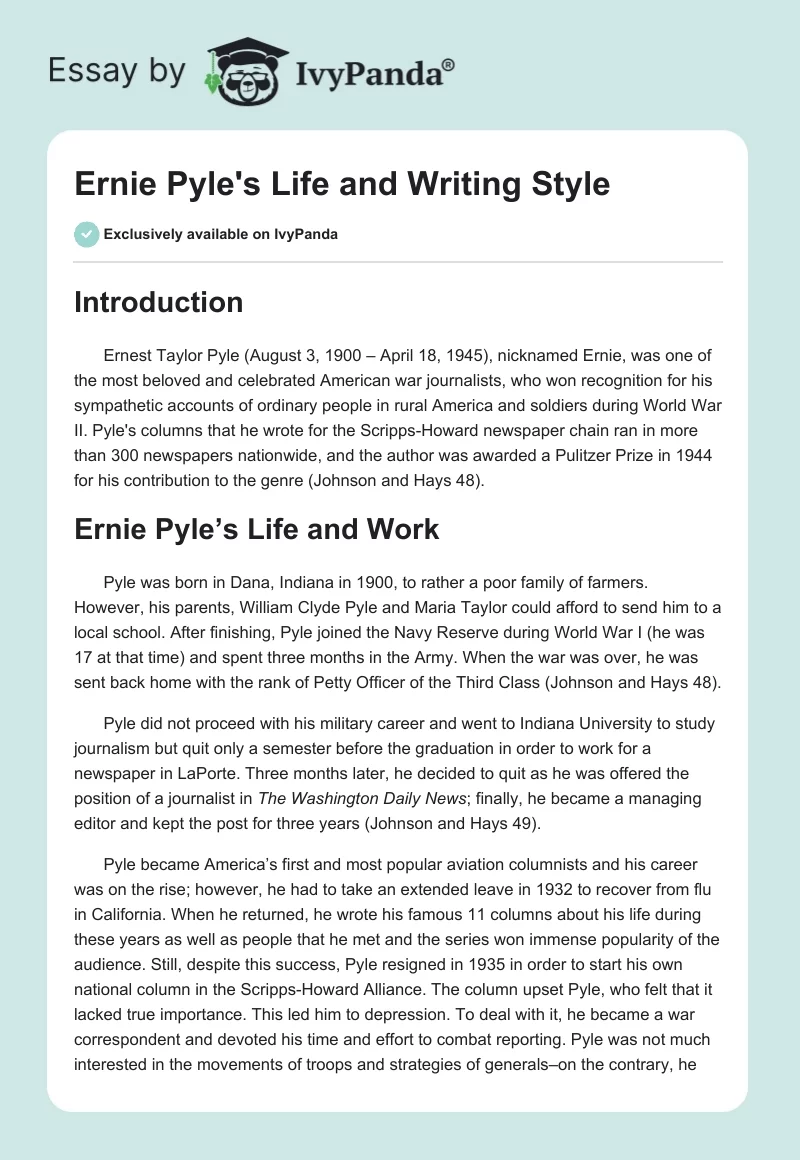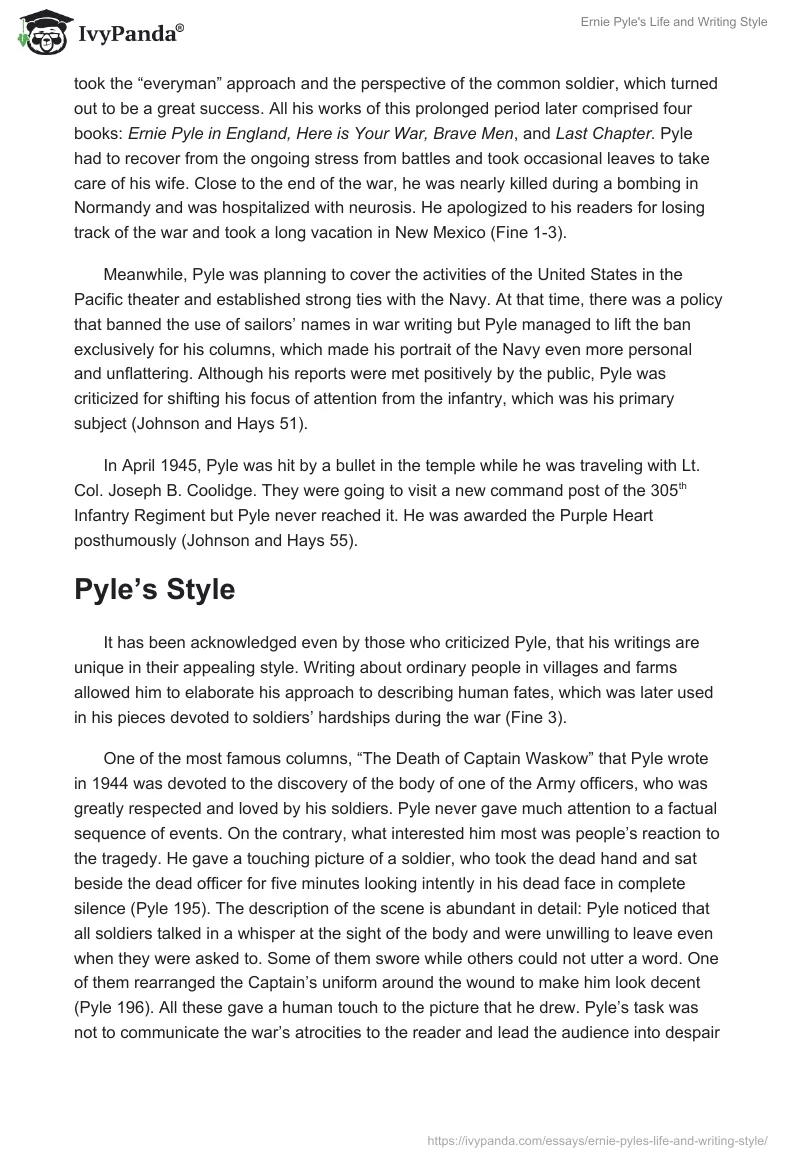Introduction
Ernest Taylor Pyle (August 3, 1900 – April 18, 1945), nicknamed Ernie, was one of the most beloved and celebrated American war journalists, who won recognition for his sympathetic accounts of ordinary people in rural America and soldiers during World War II. Pyle’s columns that he wrote for the Scripps-Howard newspaper chain ran in more than 300 newspapers nationwide, and the author was awarded a Pulitzer Prize in 1944 for his contribution to the genre (Johnson and Hays 48).
Ernie Pyle’s Life and Work
Pyle was born in Dana, Indiana in 1900, to rather a poor family of farmers. However, his parents, William Clyde Pyle and Maria Taylor could afford to send him to a local school. After finishing, Pyle joined the Navy Reserve during World War I (he was 17 at that time) and spent three months in the Army. When the war was over, he was sent back home with the rank of Petty Officer of the Third Class (Johnson and Hays 48).
Pyle did not proceed with his military career and went to Indiana University to study journalism but quit only a semester before the graduation in order to work for a newspaper in LaPorte. Three months later, he decided to quit as he was offered the position of a journalist in The Washington Daily News; finally, he became a managing editor and kept the post for three years (Johnson and Hays 49).
Pyle became America’s first and most popular aviation columnists and his career was on the rise; however, he had to take an extended leave in 1932 to recover from flu in California. When he returned, he wrote his famous 11 columns about his life during these years as well as people that he met and the series won immense popularity of the audience. Still, despite this success, Pyle resigned in 1935 in order to start his own national column in the Scripps-Howard Alliance. The column upset Pyle, who felt that it lacked true importance. This led him to depression. To deal with it, he became a war correspondent and devoted his time and effort to combat reporting. Pyle was not much interested in the movements of troops and strategies of generals–on the contrary, he took the “everyman” approach and the perspective of the common soldier, which turned out to be a great success. All his works of this prolonged period later comprised four books: Ernie Pyle in England, Here is Your War, Brave Men, and Last Chapter. Pyle had to recover from the ongoing stress from battles and took occasional leaves to take care of his wife. Close to the end of the war, he was nearly killed during a bombing in Normandy and was hospitalized with neurosis. He apologized to his readers for losing track of the war and took a long vacation in New Mexico (Fine 1-3).
Meanwhile, Pyle was planning to cover the activities of the United States in the Pacific theater and established strong ties with the Navy. At that time, there was a policy that banned the use of sailors’ names in war writing but Pyle managed to lift the ban exclusively for his columns, which made his portrait of the Navy even more personal and unflattering. Although his reports were met positively by the public, Pyle was criticized for shifting his focus of attention from the infantry, which was his primary subject (Johnson and Hays 51).
In April 1945, Pyle was hit by a bullet in the temple while he was traveling with Lt. Col. Joseph B. Coolidge. They were going to visit a new command post of the 305th Infantry Regiment but Pyle never reached it. He was awarded the Purple Heart posthumously (Johnson and Hays 55).
Pyle’s Style
It has been acknowledged even by those who criticized Pyle, that his writings are unique in their appealing style. Writing about ordinary people in villages and farms allowed him to elaborate his approach to describing human fates, which was later used in his pieces devoted to soldiers’ hardships during the war (Fine 3).
One of the most famous columns, “The Death of Captain Waskow” that Pyle wrote in 1944 was devoted to the discovery of the body of one of the Army officers, who was greatly respected and loved by his soldiers. Pyle never gave much attention to a factual sequence of events. On the contrary, what interested him most was people’s reaction to the tragedy. He gave a touching picture of a soldier, who took the dead hand and sat beside the dead officer for five minutes looking intently in his dead face in complete silence (Pyle 195). The description of the scene is abundant in detail: Pyle noticed that all soldiers talked in a whisper at the sight of the body and were unwilling to leave even when they were asked to. Some of them swore while others could not utter a word. One of them rearranged the Captain’s uniform around the wound to make him look decent (Pyle 196). All these gave a human touch to the picture that he drew. Pyle’s task was not to communicate the war’s atrocities to the reader and lead the audience into despair about its outcomes but also to emphasize that there was still love, friendship, heroism, and hope.
Furthermore, this work is demonstrative of the author’s desire to give the war a personal face. Pyle was eager to show that statistics of the killed and injured meant real people standing behind the numbers, who had the right to be paid homage even if they did nothing on the global scale and did not produce any decisive impact on the outcome of the battle. His personal approach was emphasized also by the way he addressed his writings: All the columns were written in a letter-like style to make each reader feel personally involved in the events (Fine 5).
Pyle was highly sensitive to the choice of the words he used. Captain Waskow was one of the few exceptions to the rule of never mentioning people’s ranks. Pyle applied the word “soldier” to everyone regardless of the position and emphasized the fact that bodies were always put in one row before the burial: no one ever thought of preserving their status while doing this. His description of soldiers is all heavily loaded with connotations to make the reader see how the war dehumanizes people making them look like wild beast whereas deep in their hearts they still have their hopes, affections, and faith. Pyle was a pacifist and the major message of all his columns was that the war was a useless hostility that had to be put an end to (Fine 7).
Another famous piece, called “The God-Damned Infantry”, is fully devoted to the description of the deplorable condition, in which he found infantrymen in 1943. People were so exhausted and miserable that “you almost feel ashamed to look at them” (Pyle 112). They were all young boys but the war disfigured them so much that they resembled old men, black, unshaven, shabby but resolute to go further despite being totally worn out (Pyle 113).
It is also worth mentioning that Pyle rarely resorted to any kinds of exaggeration despite the fact that his ultimate goal was to impress the reader and make him/her feel engagement. In this very piece of writing, he stressed the fact that there was no hatred or aggression in the eyes of soldiers and they were not even in despair–“there is just the simple expression of being here as though they had been here doing this forever, and nothing else” (Pyle 112). He could have used his favorable position as a war reporter to add more colors to the events that no one witnessed. However, he was neither pompous nor pathetic. This made his columns so much true-to-life that no one ever doubted that Pyle gave a credible account of the war without trying to turn it into a piece of fiction.
Yet, Pyle’s personal problems with his psychological health could not help affecting his prose and made reporting particularly challenging for him. He suffered from severe fits of neurosis and frequently fell into depression. This becomes evident when we read pieces published closer to the end of the war when he no longer saw any hope and was majorly grim and pessimistic (Fine 12).
Despite the personal approach that Pyle took in all his works, he was paradoxically absent and humbly stayed in the shadow. He put the spotlight on his subjects but never on himself and did not boast of any of his personal achievements, which made some readers doubt that all the columns belonged to one and the same man.
Both his contemporaries and modern critics acknowledge that Pyle is an extraordinary figure in journalism and his deep respect for people, about whom he wrote, as well as his sympathy and personal involvement are the things that a lot of writers lack today.
Works Cited
Fine, Richard. “The Development of the Pyle Style of War Reporting: French North Africa, 1942–1943.” Media History, 2017, pp. 1-15.
Johnson, Owen V., and Holly Hays. “Wrestling with Fame: Ernie Pyle and the Pulitzer Prize.” Traces of Indiana and Midwestern History,vol. 28, no. 2, 2016, pp. 48-56.
Pyle, Ernie. Ernie’s War: the Best of Ernie Pyle’s World War II Dispatches. Random House Incorporated, 1986.


